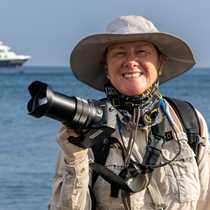By daylight we were anchored next to this iconic island, Sombrero Chino. Translated literally, it means Chinese hat, and that describes the outline perfectly. Between Sombrero Chino and the island of Santiago, there lies a shallow, white-sand-bottom channel. After breakfast we all got into the Zodiacs and took a ride along both shorelines of this channel, finding blue-footed boobies, striated herons, great blue herons, sea lion pups and the dramatic, harsh landscape of relatively fresh lava. In 1897 a ship was anchored in the area and witnessed the flow erupt from a minor vent on the eastern side of Santiago Island (then called James Island after King James). About 50 square miles were covered in the event.
Our hope was to find the Galapagos penguin, but it wasn’t to be, until later when we went back for snorkeling. The water was temperature-perfect, the sky had cleared into a baby blue and the visibility was ideal. It felt as if we were in an aquarium. Colorful fish were minding their business, marine iguanas were feeding underwater, a few guests were lucky enough to see penguins in the water and all got to see one that hopped out onto a rock for preening and rest. I felt fortunate to see a pair of spiny lobsters interacting then separating as they went their own way. Greg pointed out a beautiful flowery flounder I would otherwise have missed (that’s why it is always better to snorkel with a buddy). It was one of the larger individuals I’ve seen over the years, and quite cooperative (can you see the mouth? How about the tentacles on the eyes?).
As we sailed away from Sombrero Chino, we passed close by one of the Bainbridge Islets; one whose conical form has been seriously eroded away on the outside, leaving a thin, fragile rim only a few meters high between its briny lagoon and the blue ocean outside. Captain Jaramillo maneuvered the NG Islander just right and those on the sky deck could peer into the lagoon and…yes! Flamingos! About 12 flamingos were bunched in the middle, creating a spot of color in an otherwise earth-tone bowl of arid vegetation under a hot sky.
After lunch, after a rest, we once more departed, this time for a walk on the very lava flow we had been gazing at all morning – except from the opposite side. This location is known as Sullivan Bay and from a distance it seems to be a desolate expanse of nothingness, yet once on land, the fascinating details are realized-the forms and flows, the ripples and curves. Long before our most famous human sculptors made marble look like folds of cloth, flowing lava laid down the most beautiful forms. Pioneer plants Mollugo and Brachycereus have taken hold in a few cracks and crevasses, the first and most certainly not the last to colonize this bleak vastness. Three of us went for a Zodiac ride along the coast of Santiago, with the sun getting lower with every minute that passed. Fortune was with us, however, and two penguins on a rock were spotted.
As the sun settled down in the western sky, everyone came home.







